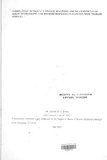| dc.description.abstract | Introduction:The thyroid is an endocrine gland involved in the homeostatic regulation of man by means of its products, the hormones tri-iodothyronine (T3), and thyroxine (T4), which is in turn regulated by thyroid stimulating hormone (TSH), produced by the anterior pituitary gland: Its basic morphologic unit is the follicle, composed of follicular cells which produce the hormones T3 and T4, The diseases affecting the thyroid are classified into benign and malignant lesions or disorders of thyroid function, hyperthyroidism and hypothyroidism. Thyroid dysfunction is evaluated by measuring serum TSH, T3 and T4 which will establish euthyroidism,hyperthyroidism and hypothyroidism. Fine needle aspiration (FNA) is the diagnostic test of choice in determining whether a nodule is benign or malignant. It has not been established, whether the various lesions diagnosed by FNA have differing hormonal profiles, and this is the main research problem being investigated.
Aims and Objectives: The aim of the study was to establish cytologic diagnosis of thyroid
nodules and to determine the serum total T3, T4 and TSH levels in the same patients. It also sought to correlate the hormonal levels to the cytologic findings and to make recommendations on the use of FNA and hormonal analysis for improved diagnosis and patient management.
Study Design: A cross-sectional study of 42 patients with thyroid nodules was done at Kenyatta National Hospital (KNH) between June and August 2001.
Study area and population: The study involved patients who presented to the Surgical Outpatient Clinic (Thyroid and FNA clinic) with a thyroid nodule at KNH over the same period. Inclusion criteria included any patient who had a nodular or diffuse thyroid goiter, a request for FNA by the attending clinician, informed consent and exclusion criteria included any patient who was on treatment for a thyroid disorder, or refused informed consent.
Methodology. FNA cytologic diagnosis was performed by the investigator and confirmed by a cytopathologist in the Department of Human Pathology. Serum total T3, T4 and TSH levels were performed in the Department of Clinical Chemistry, using the Serozyme ELISA technique.
Results: The data was analyzed to evaluate the correlation between FNA diagnosis and hormonal levels.There were 37 (88.09%) females and 5 (11.90%) males giving a female to male ratio of 7 : 1. The hormonal profile after biochemical analysis showed that 26 (61.6%) patients had a hormonal profile of euthyroidism, 5 (11.5%) had hyperthyroidism, 8 (19%) had compensated hyperthyroidism, 2 (4.76%) had subclinical hyperthyroidism and 1 (2.3%) had subclinical hypothyroidism. Patients with FNA cytological diagnosis of nodular goitre comprised 35 (83.3%), non-diagnostic samples 3 (7.14%), papillary carcinoma, atypia, thyroglossal cyst and thyroiditis 1 (2.38%) each. With a confidence interval of 95% and p<0.05 there was no significant statistical difference of the mean levels ofT4 (p=OA06), T3 (p=0.311), and TSH (p=0.90), between and within the various groups of FNA cytological diagnoses.
Conclusion: The study showed there was no correlation between hormonal profile and FNA cytological diagnoses. Both biochemical analysis and FNA biopsy, offered to the clinicians the possibility of early diagnosis of both thyroid function and benign and malignant lesions, and to determine the course of therapy in the management of patients with thyroid nodules.
Recommendation: FNA cytology and thyroid function tests should be reinforced as routine diagnostic procedures at KNH for the diagnosis and management of patients with enlarged thyroid glands and adequate rational resources allocated to the concerned departments and laboratories. There is need to conduct a comprehensive prospective study at KNH to correlate hormonal profile, preferably FT4, FT3 and TSH, with cytology and histology where time, resources and an adequate sample size is considered. | en_US |

